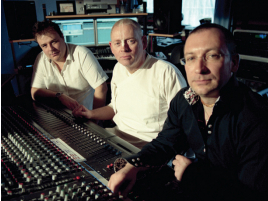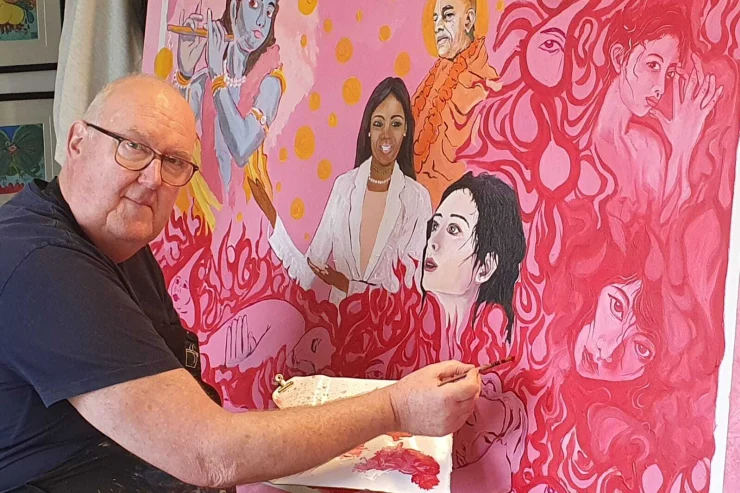Kripamoya Sets a New Bar for Devotional Music with “Chakram”
By Madhava Smullen | Nov 19, 2011

As a young man still in school, music meant a lot to Kripamoya Dasa—then Michael Harrison—who fronted his own band and attended all the big outdoor pop festivals. So it was a big deal for him, when, in 1972, he stood on a hill in the cold English rain in Buxton, Darbyshire, to watch the guitar legend Chuck Berry.
But strangely, it was after Berry’s performance had been interrupted by the Hell’s Angels Motorcycle Gang that young Michael saw the musical performance that completely changed his life.
“As the rain got heavier and I was getting ready to leave, I spotted four Hare Krishna devotees dancing and chanting,” he says now. “And the curious thing was, they were dancing in the mud. I gazed at them in awe, rooted to the spot. I could understand that they were special people, and that the chant they were absorbed in was even more special. I found myself hypnotized by it.”
Nearly forty years later, Kripamoya has released his own album of traditional devotional chants with a difference that many are calling a new benchmark in ISKCON devotee-produced music.
It’s not his first. In the last decade, he’s released three kirtan albums—the puntastically titled “Now That’s What I Call Bhajans!”; Time to Rise, a guide to temple songs and chants for the new congregational members he was helping to train in Krishna consciousness; and the commemorative Kripamoya: Thirty Years of Kirtan. But this year’s Chakram, with its lush orchestral arrangements and filmic soundscapes, is by far his most elaborate effort to date.
“It was born in 2009, during the fortieth anniversary of Sri-Sri Radha-Londonisvara, the presiding Deities of ISKCON London,” Kripamoya says. “We wanted to make a celebratory album that would be an audio snapshot of devotees who served Them throughout Their history. I recorded a track for the album at Arcade Studio, featuring the studio’s owner Pete Booker on piano. Devotees loved it, and asked for more. So we decided to make a kirtan album with Western instruments—but rather than doing rock ‘n’ roll or pop as other devotees have done in the past, we decided to use classical instrumentation.”
For Chakram, Kripamoya used ISKCON London’s long and illustrious musical history to amass a group of some of the most celebrated and talented musicians, producers, engineers and artists in the business.

The album cover art of Chakram
“England is well known for its musicians, and ISKCON began in England when we connected with its most famous musicians ever—The Beatles, and specifically George Harrison,” he says. “People remember us for our connection with him, and have been reminded again by Martin Scorcese’s just-released documentary George Harrison: Living in the Material World.”
Then there’s the connection with Boy George, whose 1991 Top 30 hit featured Jayadev Dasa on drums and included the lyrics, “Bow down Mister, Hare Rama Hare Krishna, bow down Mister, we say Radhe Shyam.” And the connection with Kula Shaker, whose 1996 hits “Tattva” and “Govinda” featured Krishna conscious lyrics and reached number #4 and #7 in the charts respectively.
“So when we speak to musicians, there’s a smile of recognition, and they say, ‘Oh yeah, Hare Krishna, I know,’” says Kripamoya.
Thus, Chakram was recorded in Arcade Studio by Pete Booker, who has produced for the BBC and Channel 4. It was produced by Kiron J—better known in ISKCON as initiated devotee Jagannath Suta Dasa—who has worked on TV commercials and film soundtracks for Universal Music and Sony BMG. And it was mastered at Metropolis Studio by Alec “Hippy” Baldwin, who has mastered albums for The Who, David Gilmour of Pink Floyd, and KT Tunstall.
Meanwhile the album cover’s mindblowing design was created by professional graphic designer Madhusudhana Dasa, and its beautiful photography taken by Dave Evans, a TV broadcast cameraman for the BBC. And one of its major financial backers is another BBC professional who originally worked on ISKCON devotees’ Top of the Pops performance of the Hare Krishna Mantra in 1969.
The music itself is just as grand. Jagannath Suta’s film experience and training in the art of Foley sound effects bring a multi-layered texture and a big, epic sound unlike anything heard before on a bhajan album.

Kripamoya’s daughters Tulasi (left, with kartalas) and Jahnavi (right, with violin) perform the album Chakram live with their father
“We wanted to create something that sounded like the score to a Vaishnava film,” Kripamoya says.
Despite all the bluster of its sound and talent, however, the album itself is not, as Kripamoya puts it, “happy clappy,” but rather a very personal effort that holds deep meaning for him.
“I came through cancer twice recently,” he explains. “So it is a meditation on protection from the Lord. That’s why it’s called Chakram, after Lord Krishna’s Sudarshana Chakra, which He uses to protect His devotees and vanquish evil. The first track in particular, Narasimha Vijaya, is dedicated to Lord Nrsimhadeva, God’s ferociously protective half-man half-lion form. Musically, it suggests a struggle, then attaining protection.”
The second track, Hymn to A Goddess, is a reworking of Narottama Dasa Thakura’s “Sri Rupa Manjari Pada,” inspired by the late Vishnujana Swami’s classic ISKCON version.
“His version is one of my favorite songs from years ago,” Kripamoya says. “And although his pronunciation is evocative of a time when no one really knew how to pronounce Sanskrit, I reproduced it on my song as a homage to him. Because he was the soundtrack of many devotees’ early days in Krishna consciousness including mine, and shaped ISKCON’s bhajan tradition for years to come.”
Other tracks include Dancing in the Streets (Nadiya Godrume Nityananda Mahajana), one of eight songs written by Bhaktivinode Thakura for public performance of kirtan. There’s also The Great Chariot Festival (Jaya Jaya Jagannath Sacira), a song by Vasudeva Ghosa about the wonder of how the golden Chaitanya Mahaprabhu, the blue Lord Krishna, and the green Lord Rama are all the same Supreme Lord. And Sarvasvar Tomar, from Bhaktivinode Thakura’s “Saranagati” or
“Surrender”, wherein he asks to be accepted as the Lord’s pet dog.

An orchestral quartet plays Chakram live
Then there’s Sacred Landscapes of Braj (Jaya Radhe, Jaya Krishna); Let the Bee of My Mind Fly to the Eternal Lotus (Krishna Deva Bhavantam Vande); Father, What is the Spirit (a compilation of verses from the Upanishads) and Kevalastakam, an anonymous poem describing the Holy Name of the Lord as the only real thing in this world.
Kripamoya chose lesser known songs to give the devotee world something they haven’t heard before, with plenty of musical surprises and guest vocalists too. Kevalastakam and Hymn to a Goddess feature an orchestral quartet of cello, viola and two violins, while the latter song includes the soaring vocals of second-generation kirtaniya Chakrini.
Dancing in the Streets features Moroccan drum, Sacred Landscapes of Braj is set to an Irish melody, with accompanying vocals by Hari Kirtan, Father What is the Spirit boasts Middle Eastern melodies, and Let the Bee of My Mind… features singing and South Indian Carnatic violin from Kripamoya’s daughter Jahnavi.
“I banned sitars and tablas,” Kripamoya laughs. “We didn’t want it to be predictable at all.”
His primary goal in making the album, however, was to create something that, while having a world feel to it, was devotionally inspiring and true to Vaishnava heritage.
“I would discuss the mood that was being expressed in each song in detail, and then we would try to capture that with voices and instruments,” Kripamoya says. “I’d also fast before I came into the studio, so that I’d be singing the songs with a clear head.”
Kripamoya is aiming for a broad audience with Chakram. Released on Jagannath Suta’s Radha Krishna Records, the album is being promoted with reviews and competitions in major UK yoga magazines Spirit and Soul and Kindred Spirit, read by 20,000 people each. Several tracks from it are being sent as musical e-cards to the 15,000-person email list of St. James’ Church in Picadilly. Copies of the album have been submitted to film companies around London, it is being sold by several alternative booksores, and negotiations are underway to see it stocked by major recordstore chain HMV.
“The album is meant not just for devotees, but for anyone interested in spirituality,” Kripamoya says. “I hope that by hearing these songs, people will come to know the depth of the musical tradition we have, and through understanding the lyrics from http://chakram108.wordpress.com, come closer to Krishna consciousness.”
It’s this spiritual goal that drives Kripamoya’s promotion of Chakram, not personal gain. The facts speak for themselves: fifty per cent of the album’s proceeds will go to Bhaktivedanta Manor, while the other fifty per cent will go to Radha Krishna Records to support further production of devotional albums.
“We would like to give our wonderful Vaishnava musical heritage to the world, and to see Bhaktivinode Thakura’s songs become famous everywhere,” Kripamoya says.

Kripamoya Dasa performs songs from Chakram live at the Janmastami Festival at Bhaktivedanta Manor















